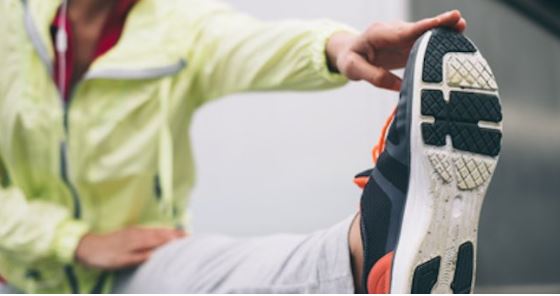Flexibility training is perhaps the most undervalued component of conditioning. While recent and ongoing debate questions its role in injury prevention, athletes can still gain much from a stretching regime.
From a volleyball spike to a rugby drop kick, flexibility of the bodys muscles and joints play an integral part in many athletic movements.
In general terms, flexibility has been defined as the range of motion about a joint and its surrounding muscles during a passive movement (1,2). Passive in this context simple means no active muscle involvement is required to hold the stretch. Instead gravity or a partner provides the force for the stretch.
The Benefits of Flexibility Training
By increasing this joint range of motion, performance may be enhanced and the risk of injury reduced (3,4). The rationale for this is that a limb can move further before an injury occurs.
Tight neck muscles for example, may restrict how far you can turn your head. If, during a tackle, your head is forced beyond this range of movement it places strain on the neck muscles and tendons.
Ironically, static stretching just prior an event may actually be detrimental to performance and offer no protection from injury (5,6). The emphasis is on “may” however, as a closer examination of the scientific literature shows that effects are often minimal and by no means conclusive.
Muscle tightness, which has been associated with an increased risk of muscle tears (7,8), can be reduced before training or competing with dynamic stretching. For this reason many coaches now favor dynamic stretches over static stretches as part of the warm up.
Competitive sport can have quite an unbalancing effect on the body (9,10). Take racket sports for example. The same arm is used to hit thousands of shots over and over again. One side of the body is placed under different types and levels of stress compared to the other. The same is true for sports like soccer and Australian rules football where one kicking foot usually predominates. A flexibility training program can help to correct these disparities preventing chronic, over-use injury.
Of course, a more flexible athlete is a more mobile athlete. It allows enhanced movement around the court or field with greater ease and dexterity. Some other benefits may include an increase in body awareness and a promotion of relaxation in the muscle groups stretched – both of which may have positive implications for skill acquisition and performance.
Types of Flexibility and Stretching
1. Dynamic flexibility — the ability to perform dynamic movements within the full range of motion in the joint. Common examples include twisting from side to side or kicking an imaginary ball. Dynamic flexibility is generally more sport-specific than other forms of mobility.
2. Static Active flexibility — this refers to the ability to stretch an antagonist muscle using only the tension in the agonist muscle. An example is holding one leg out in front of you as high as possible. The hamstring (antagonist) is being stretched while the quadriceps and hip flexors (agonists) are holding the leg up.
3. Static Passive flexibility — the ability to hold a stretch using body weight or some other external force. Using the example above, holding your leg out in font of you and resting it on a chair. The quadriceps are not required to hold the extended position.
A flexibility training program can be made up of different types of stretching:
- Dynamic stretching
- Ballistic stretching
- Static Active stretching
- Static Passive stretching
- Isometric stretching
- PNF stretching
Which type of flexibility training is best?
It depends on the sport and the athlete’s outcomes – something which will be examined more closely in the articles below. As a general rule, dynamic stretches are used as part of a warm up and static stretches or PNF flexibility training is used for increasing range of motion.
Flexibility Training Articles
The Physiology of Flexibility
Here’s a quick review of what determines a person’s flexibility – an some of the physiological components important in stretching…
Static Stretching Exercises and Flexibility Training Program
Static stretching exercises are best performed when your body is completely warmed up – often at the end of game or training session. Avoid static stretching immediately before competition, especially if your sport is speed and power based…
Upper & Lower Body lexibility Exercises
This compilation of flexibility exercises targets all the major muscle groups…
Dynamic Stretches & Stretching Routine
Use these dynamic stretches as part of your warm up routine. Dynamic stretching has been shown to decrease muscle tightness which may be associated to an increased risk of muscles and tendon tears…
Self Myofascial Release Exercises
While not strictly flexibility training, self myofascial release techniques can have a number of performance and rehabilitation benefits. With just the aid of a foam roll, athletes can reduce muscular pain and those ‘trigger points’ also associated with muscle tears…
References
1) Cornelius, W.J., and M.M. Hinson. The relationship between isometric contractions of hip extensors and subsequent flexibility in males. Sports Med. Phys. Fitness 20:75-80. 1980
2) Fox, E.L. Sports Physiology. Philadelphia. Saunders. 1979
3) Cross, K.M., and T.W. Worrell. Effects of a static stretching program on the incidence of lower extremity musculotendinous strains. J. Athl. Training 34:11-4. 1999
4)Hartig, D.E., and J.M. Henderson. Increasing hamstring flexibility decreases lower extremity overuse injuries in military basic trainees. Am. J. Sports Med. 27:173-176. 1999
5) Pope, R.P., Herbert, R.D., and J.D. Kirwan. A randomised trial of pre-exercise stretching for prevention of lower limb injury. Med. Sci. Sports Exerc. 32:271-7. 2000
6) Shrier, I. Stretching before exercise does not reduce the risk of local muscle injury: A critical review of the clinical and basic science literature. Clinical J. Sports Med. 9: 221-7. 1999
7) Witvrouw, E., Danneels, L., Asselman, P., D’Have, T., Cambier, D. Muscle flexibility as a risk factor for developing muscle injuries in male professional soccer players. A prospective study. Am. J. Sports Med. Jan-Feb;31(1):41-6. 2003
8) Krivickas, L.S., Feinberg, J.H. Lower extremity injuries in college athletes: relation between ligamentous laxity and lower extremity muscle tightness. Arch. Phys. Med. Rehabil. Nov;77(11):1139-43. 1996
9) Orchard, J., Marsden, J., Lord, S., Garlick, D. Preseason hamstring muscle weakness associated with hamstring muscle injury in Australian footballers. Am. J. Sports Med. Jan-Feb;25(1):81-5. 1997
10) Tyler, T.F., Nicholas, S.J., Campbell, R.J., McHugh, M.P. The association of hip strength and flexibility with the incidence of adductor muscle strains in professional ice hockey players. Am. J. Sports Med. Mar-Apr;29(2):124-8. 2001

























